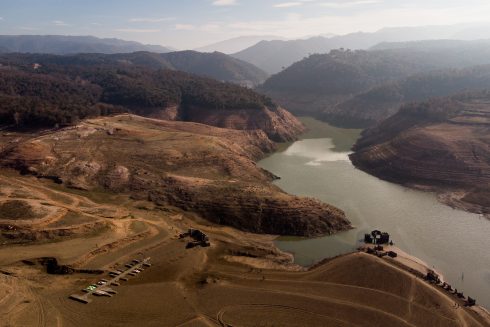A SERIES of devastating floods caused by massive rainfall have hit cities around the globe so far this century – and Valencia is just the latest.
From Mumbai and New Orleans in 2005 to Houston in 2017 and Athens last year, thousands have died in these floods.
While abnormally high levels of rain – and in the case of New Orleans, hurricanes – were mostly blamed, another key factor has been the over-construction of properties on flood plains and over-use of concrete, which doesn’t absorb water.
In response, a new wave of flood mitigation strategies are being developed with nature-based solutions at their core.
READ MORE:
In some cases they are simply relearning old knowledge that had either been forgotten or dismissed as irrelevant in the quest to build ever more property.
“Everyone has got to stop using concrete. This is the worst material to use,” insists respected Pakistan architect Yasmeen Lari. “If you look at urban flooding, the reason it’s becoming worse is because we’ve got concrete paving everywhere. Water is not able to steep into the soil.”
Meanwhile, too many floodplains have been built on, not only leaving these properties vulnerable to flooding but also endangering previously safe areas which had been protected by wetlands absorbing excess water.
Nature-based solutions seek to restore and enhance nature zones – such as wetlands and woodlands – to reduce flood risks while delivering additional benefits like improved biodiversity and enhanced urban environments.
Ironically, Valencia city itself has been seen as one of the pioneers in this movement.

It has started to implement green roofs, vertical gardens, and transformed the former river Turia’s floodplain into a park, providing natural flood defences that help absorb excess water and reduce urban heat.
But the sheer quantity of the water that was dumped overwhelmed these defences, with deadly results in the suburbs and nearby towns.
Much more needs to be done in what has been a slow process in ‘greening’ Valencia and other cities around the world.
Water plaza
One city with an innovative approach to flood prevention is Rotterdam.
It has created a ‘water plaza’, for example, that doubles up as temporary stormwater storage area during heavy rainfall, preventing street overflows that can paralyse the city.

When not serving as an emergency reservoir, it is used for recreation, offering sports facilities for residents.
Meanwhile in Singapore, the ABC Waters Programme is transforming canals, drains, and reservoirs into scenic, green spaces. Not only does this help mitigate flood risk, but it also creates spaces for relaxation and recreation.
Cities world-wide are adopting green infrastructure – such as green roofs which are covered with vegetation to absorb rainfall and permeable pavements which allow water to seep into the ground rather than flood into drains.
In Copenhagen, for example, a company called Tredje Natur has developed a perforated ‘climate tile’ which absorbs much more rainwater.
Sponge cities
Perhaps one of the most interesting developments in flood management is the concept of the sponge city, which is gaining popularity in China.
A concept invented by landscape architect Kongjian Yu, his ideas were adopted by the Chinese government in 2013 following mass floods.
A pilot programme was tested across 30 cities, including Sanya, where previous concrete flood walls were replaced by sponge-like wetlands, terraced embankments, ponds and paddy fields that could absorb 830,000 cubic metres of stormwater at one time.
Wuhan meanwhile, was designed to capture, clean, and store rainwater rather than funnel it away.

The water can then be used within the city rather than run into drainage and sewer systems that could otherwise be overwhelmed.
Meanwhile, floodplains are being restored as part of efforts to manage flood risks.
Restoring them not only helps prevent flooding by holding excess water but also supports biodiversity by providing habitats for wildlife.
While nature-based solutions are crucial, traditional flood defences like stormwater systems and flood walls are still needed.
Blue green infrastructure
New York and Miami have blended the old with the new through ‘blue-green infrastructure’ – a hybrid solution that combines water management with green spaces.
In New York’s Lower Manhattan Coastal Resiliency Project, this involves seawalls, elevated streets, and wetlands to shield vulnerable areas from the rising waters and hurricanes that have become an increasing threat.

In Los Angeles ‘green alleys’ have been installed leading to a basin to capture the water and make the city more ‘spongier’. This year after historic rainfall fell in February, the city captured an incredible 13.5 billion gallons of stormwater, which can serve 165,000 households for an entire year.
In Vienna, meanwhile, a new suburb called Am Seebogen is using the classic sponge city model to plant thousands of trees supported by subterranean chambers that capture and store rainwater which can be used during long dry spells.
One of the most famous flood defences is the Thames Barrier in London.

Until installed in 1982, the city had frequently flooded since Roman times, but in 1953 the North Sea Flood led to hundreds of deaths.
The giant barrier is a good example of how real-time data, tide predictions, and sophisticated climate models can be used to protect the city by anticipating imminent flood risks and trigger early warning systems.
Cities including Bangkok and Manila are also tapping into these technological advancements, deploying early warning systems that use predictive analytics to give residents and authorities the time they need to take action before disaster strikes.










